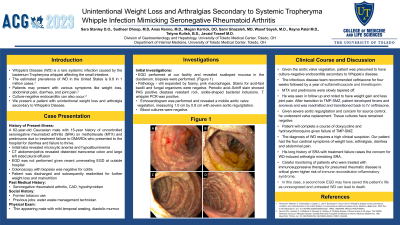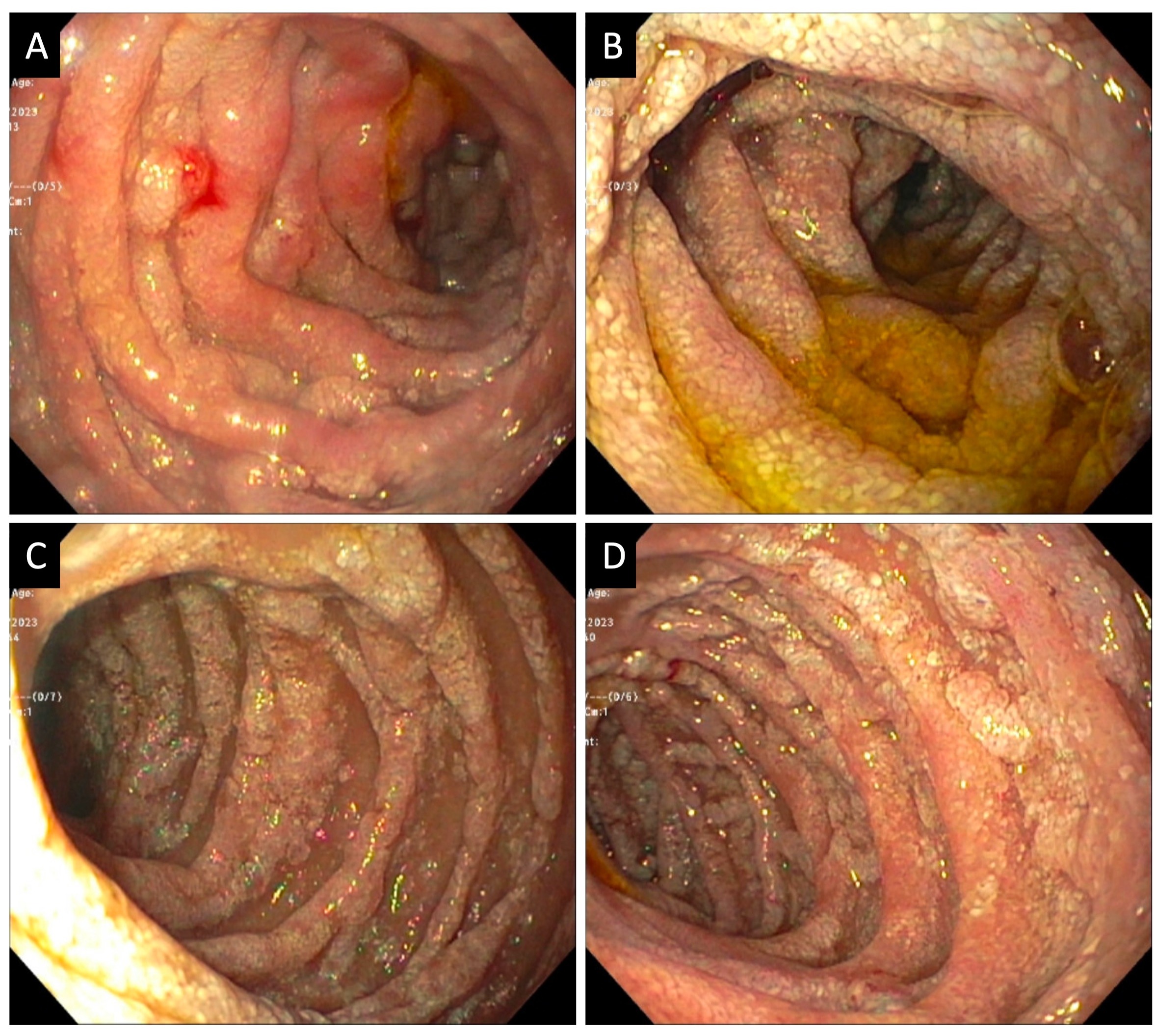Tuesday Poster Session
Category: Small Intestine
P4154 - Unintentional Weight Loss and Arthralgias Secondary to Systemic Tropheryma Whipple Infection Mimicking Seronegative Rheumatoid Arthritis
Tuesday, October 24, 2023
10:30 AM - 4:00 PM PT
Location: Exhibit Hall

Has Audio
- SS
Sara Stanley, DO
University of Toledo
Toledo, OH
Presenting Author(s)
Sara Stanley, DO1, Sudheer Dhoop, MD2, Anas Renno, MD1, Megan Karrick, DO1, Sami Ghazaleh, MD1, Wasef Sayeh, MD1, Rayna Patel, MD1, Sahithi Chinnam, DO1, Tetyana Kulish, 3, Toseef Javaid, MD1
1University of Toledo, Toledo, OH; 2University of Toledo Medical Center, Toledo, OH; 3Wayne State University, Detroit, MI
Introduction: Whipple's Disease (WD) is a rare systemic infection caused by the bacterium Tropheryma whipplei affecting the small intestine. The estimated prevalence of WD in the United States is 9.8 in 1 million cases. Patients may present with various symptoms like weight loss, abdominal pain, diarrhea, and joint pain. Culture-negative endocarditis can also occur. We present a patient with unintentional weight loss and arthralgia secondary to Whipple’s Disease.
Case Description/Methods: A 62-year-old Caucasian male with 15-year history of uncontrolled seronegative rheumatoid arthritis (SRA) on methotrexate (MTX) and prednisone due to treatment failure to DMARDs who presented to the hospital for failure to thrive. Initial labs revealed microcytic anemia and hypoalbuminemia. CT scan showed distended transverse colon and large left sided plural effusion. EGD was not performed given normal EGD at outside facility just months prior. Colonoscopy with biopsy was unremarkable. The patient was discharged with outpatient follow up. Patient was readmitted with worsening malnutrition. EGD was performed and revealed scalloped mucosa in the duodenum with biopsies showing villi expanded by foamy, pink macrophages. Stains for acid-fast bacilli and fungal organisms were negative. Periodic acid–Schiff stain showed PAS positive diastase resistant rod-, sickle-shaped bacterial inclusions. T. whipplei PCR was positive, confirming the diagnosis of WD. Echocardiogram was performed and revealed an aortic valve vegetation. Blood cultures were negative. The infectious disease team recommended ceftriaxone for four weeks followed by a year of sulfamethoxazole and trimethoprim. Rheumatology discontinued MTX and has slowly tapered prednisone. The patient was seen in follow up and noted to have weight gain and less joint pain.
Discussion: The diagnosis of WD requires a high clinical suspicion. Our patient had the four cardinal symptoms of weight loss, arthralgias, diarrhea and abdominal pain. His long history of SRA with treatment failure raises the concern for WD-induced arthralgia mimicking SRA. The culture-negative endocarditis is presumed to be secondary to Whipple’s disease, but not yet confirmed pending a valve replacement. Careful monitoring of patients who were treated with immunosuppresive therapy for presumed rheumatic disease is critical given higher risk of immune reconstitution inflammatory syndrome. In this case, a second look EGD may have saved this patient’s life as unrecognized and untreated WD can lead to death.

Disclosures:
Sara Stanley, DO1, Sudheer Dhoop, MD2, Anas Renno, MD1, Megan Karrick, DO1, Sami Ghazaleh, MD1, Wasef Sayeh, MD1, Rayna Patel, MD1, Sahithi Chinnam, DO1, Tetyana Kulish, 3, Toseef Javaid, MD1. P4154 - Unintentional Weight Loss and Arthralgias Secondary to Systemic Tropheryma Whipple Infection Mimicking Seronegative Rheumatoid Arthritis, ACG 2023 Annual Scientific Meeting Abstracts. Vancouver, BC, Canada: American College of Gastroenterology.
1University of Toledo, Toledo, OH; 2University of Toledo Medical Center, Toledo, OH; 3Wayne State University, Detroit, MI
Introduction: Whipple's Disease (WD) is a rare systemic infection caused by the bacterium Tropheryma whipplei affecting the small intestine. The estimated prevalence of WD in the United States is 9.8 in 1 million cases. Patients may present with various symptoms like weight loss, abdominal pain, diarrhea, and joint pain. Culture-negative endocarditis can also occur. We present a patient with unintentional weight loss and arthralgia secondary to Whipple’s Disease.
Case Description/Methods: A 62-year-old Caucasian male with 15-year history of uncontrolled seronegative rheumatoid arthritis (SRA) on methotrexate (MTX) and prednisone due to treatment failure to DMARDs who presented to the hospital for failure to thrive. Initial labs revealed microcytic anemia and hypoalbuminemia. CT scan showed distended transverse colon and large left sided plural effusion. EGD was not performed given normal EGD at outside facility just months prior. Colonoscopy with biopsy was unremarkable. The patient was discharged with outpatient follow up. Patient was readmitted with worsening malnutrition. EGD was performed and revealed scalloped mucosa in the duodenum with biopsies showing villi expanded by foamy, pink macrophages. Stains for acid-fast bacilli and fungal organisms were negative. Periodic acid–Schiff stain showed PAS positive diastase resistant rod-, sickle-shaped bacterial inclusions. T. whipplei PCR was positive, confirming the diagnosis of WD. Echocardiogram was performed and revealed an aortic valve vegetation. Blood cultures were negative. The infectious disease team recommended ceftriaxone for four weeks followed by a year of sulfamethoxazole and trimethoprim. Rheumatology discontinued MTX and has slowly tapered prednisone. The patient was seen in follow up and noted to have weight gain and less joint pain.
Discussion: The diagnosis of WD requires a high clinical suspicion. Our patient had the four cardinal symptoms of weight loss, arthralgias, diarrhea and abdominal pain. His long history of SRA with treatment failure raises the concern for WD-induced arthralgia mimicking SRA. The culture-negative endocarditis is presumed to be secondary to Whipple’s disease, but not yet confirmed pending a valve replacement. Careful monitoring of patients who were treated with immunosuppresive therapy for presumed rheumatic disease is critical given higher risk of immune reconstitution inflammatory syndrome. In this case, a second look EGD may have saved this patient’s life as unrecognized and untreated WD can lead to death.

Figure: Endoscopic findings of scalloped duodenal mucosa.
Disclosures:
Sara Stanley indicated no relevant financial relationships.
Sudheer Dhoop indicated no relevant financial relationships.
Anas Renno indicated no relevant financial relationships.
Megan Karrick indicated no relevant financial relationships.
Sami Ghazaleh indicated no relevant financial relationships.
Wasef Sayeh indicated no relevant financial relationships.
Rayna Patel indicated no relevant financial relationships.
Sahithi Chinnam indicated no relevant financial relationships.
Tetyana Kulish indicated no relevant financial relationships.
Toseef Javaid indicated no relevant financial relationships.
Sara Stanley, DO1, Sudheer Dhoop, MD2, Anas Renno, MD1, Megan Karrick, DO1, Sami Ghazaleh, MD1, Wasef Sayeh, MD1, Rayna Patel, MD1, Sahithi Chinnam, DO1, Tetyana Kulish, 3, Toseef Javaid, MD1. P4154 - Unintentional Weight Loss and Arthralgias Secondary to Systemic Tropheryma Whipple Infection Mimicking Seronegative Rheumatoid Arthritis, ACG 2023 Annual Scientific Meeting Abstracts. Vancouver, BC, Canada: American College of Gastroenterology.

